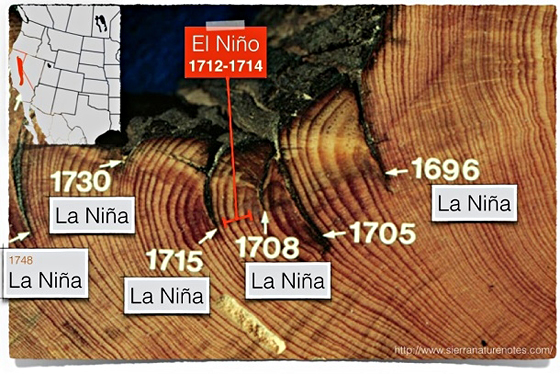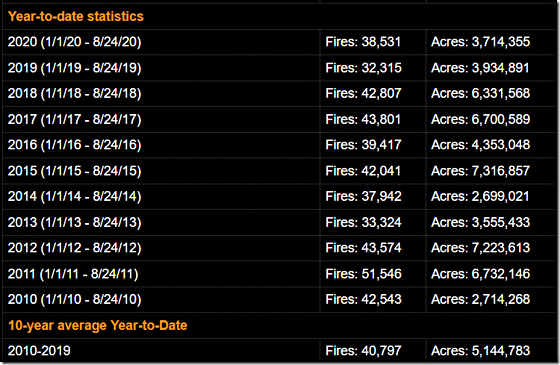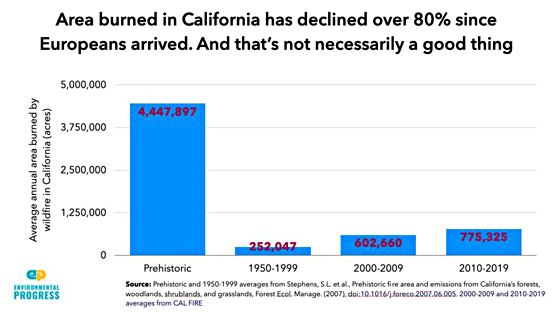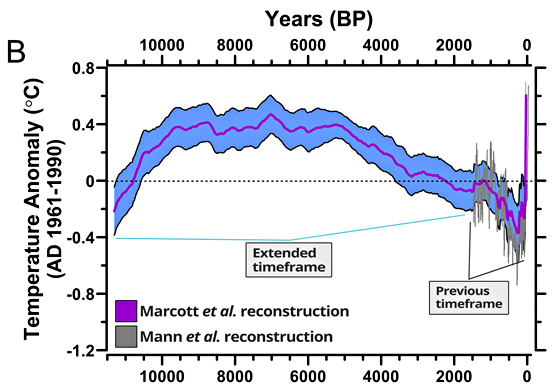If you want a sneak peek of our dystopic future under the impending Kamala Harris/Progressive Left Regency look no further than the recent utterances of California Governor Gavin Nukesom.
The latter is the poster boy for the camarilla of left-wing ideologues fixing to take power if the electorate sees fit to put Sleepy Joe in the Oval Office for an occasional oxygenated and propped-up fireside chat from his teleprompter. Commenting on the raging wildfires ravaging the state, the ever so politically correct scourge of racists, right-wing bumpkins and climate deniers decreed that:
The debate is over, around climate change,” Mr. Newsom told reporters. “This is a climate damn emergency. This is real and it’s happening.”
“I have no patience, and I say this lovingly, not as an ideologue but as someone who prides himself on being open to argument, interested in evidence…but I quite literally have no patience for climate change deniers,” the governor continued. He said skeptics’ point of view is “completely inconsistent…with the reality on the ground.”
 Cool IT (Movie Tie-in ...
Best Price: $4.87
Buy New $9.99
(as of 05:38 UTC - Details)
He acknowledged failings in forest management in recent decades, but added: “That’s one point, but it’s not the point.”
Cool IT (Movie Tie-in ...
Best Price: $4.87
Buy New $9.99
(as of 05:38 UTC - Details)
He acknowledged failings in forest management in recent decades, but added: “That’s one point, but it’s not the point.”
Oh, but drastic forestry mismanagement and negligence, which has turned much of California into a dry wood fuel dump, is exactly the point. The purported global warming has nothing to do with it.
And don’t take our word for it. This comes from the George Soros funded Pro Publica, which is not exactly a right-wing tin foil hat outfit. It points out that environmentalists have so shackled Federal and state forest management agencies that today’s tiny “controlled burns” are but an infinitesimal fraction of what Mother Nature herself accomplished before the helping hand of today’s purportedly enlightened political authorities arrived on the scene:
Academics believe that between 4.4 million and 11.8 million acres burned each year in prehistoric California. Between 1982 and 1998, California’s agency land managers burned, on average, about 30,000 acres a year. Between 1999 and 2017, that number dropped to an annual 13,000 acres. The state passed a few new laws in 2018 designed to facilitate more intentional burning. But few are optimistic this, alone, will lead to significant change.
We live with a deathly backlog. In February 2020, Nature Sustainability published this terrifying conclusion: California would need to burn 20 million acres – an area about the size of Maine – to restabilize in terms of fire.
In short, if you don’t clear and burnout the deadwood, you buildup nature-defying tinderboxes that then require only a lightening strike, a spark from an un-repaired power line or human carelessness to ignite into a raging inferno.
Indeed, in disregarding thousands of years of ecological knowledge and land stewardship practiced by indigenous peoples before the arrival of European settlers, the US government for years suppressed wildfires that were necessary to clear out overgrown vegetation and keep forests healthy. They shunned a practice, observed by hundreds of tribes in the region, of setting small, intentional fires to renew the landscape and prevent larger, more destructive wildfires – called “prescribed burns”. Over decades, Californians also built their homes into wild landscapes particularly prone to fires, and continue to do so.
Nor is it a matter of today’s authorities having somehow lost the knowledge possessed by the ancients. Tim Ingalsbee is a forty-year veteran of fighting the California fires up close and in the red hot. In 1980 he started working as a wildland firefighter, and in 1995 earned a doctorate in environmental sociology. Frustrated by the huge gap between what he was learning about fire management and experiencing on the fire line, in 2005 he started Firefighters United for Safety, Ethics, and Ecology (FUSEE).
Needless to say, FUSEE ain’t no coalition of developers, builders, utilities and chambers of commerce dedicated to turning forests and wilderness areas into concrete jungles. To the contrary, it has been lobbying Congress, and trying to educate anybody who will listen, about the misguided fire policy that is leading to today’s mega-fires.
In one pithy phrase, veteran firefighter Ingalsbee put the kibosh on the unfounded claims of Governor Newsom and the gaggle of Climate Change Howlers he represents:
…. There’s only one solution, the one we know yet still avoid. “We need to get good fire on the ground and whittle down some of that fuel load.”
Andrea Widburg of the American Thinker summed it up well:
Environmentalism is why California stopped grooming forests or doing controlled burns to get rid of deadwood (AKA tinder). It was because of environmentalism that PG&E poured all of its money into building renewable energy facilities, such as the solar facilities that failed during California’s recent heat wave, and stopped repairing old power lines (some going back 90 years) or trimming back tinder around those power lines. All this misbegotten environmentalism has controlled California even as more people have moved into fire zones over the past several decades.
In fact, a dramatically larger human footprint in the fire-prone shrub-lands and chaparral (dwarf trees) areas along the coasts increases the risk residents will start fires. California’s population nearly doubled from 1970 to 2010, from about 20 million people to 39 million people, and nearly all of the gain was in the coastal areas.
Under those conditions, California’s strong, naturally-occurring winds, which crest periodically, are the main culprit which fuels and spreads the human set blazes in the shrub-lands. The Diablo winds in the North and Santa Ana winds in the South can actually reach hurricane force. As wind moves West over California mountains and down toward the coast, it compresses, warms and intensifies. The winds blow flames and carry embers, spreading the fires quickly before they can be contained.
As one expert noted,
The first is the wind-driven fires on coastal shrub-land, or chaparral, where most of the houses are. Think: Malibu and Oakland. Nineteen of the state’s 20 most deadly and costly fires were there.
If you recognize that 100% of these [shrub-land] fires are started by people, and you add 6 million people [since 2000], that’s a good explanation for why we’re getting more and more of these fires,” said Keeley.
This year there was an especially lethal confluence of Mother Nature’s normal doings, having nothing to do with anthropogenic warming. These natural forces include the periodic La Nina cooling trend in the Pacific waters, which in turn tends to bring dry weather across portions of California and much of the Southwest.
Next, an unusually large tropical storm in the Pacific Ocean spun a massive front of moisture toward California, triggering a rare lighting storm that zapped the region more than 10,800 times over a recent three-day period, sparking small fires across the Bay Area and northern California. As Pro Publica further explained,
Then the humidity dropped and winds picked up, stoking the small flames until they erupted into full-blown infernos. One of the wildfires in northern California actually spawned a fire tornado – a 30,000 ft. smoky swirl that frizzled with lightning, prompting the National Weather Service to issue a first-of-its-kind weather alert.
The point is, none of these naturally occurring, fire-fueling forces arose suddenly subsequent to 1980 when, after purportedly inventing the computer, Al Gore went on to discover “global warming” at the end of a 1,000 year temperature hockey stick which (see below) was a fraud from the day it was concocted on Michael Mann’s hooky computer models.
Among other proofs that industrialization and fossil fuels aren’t the culprit is the fact that researchers have shown that when California was occupied by indigenous communities, wildfires would burn up some 4.5 million acres a year. That’s nearly 6X the 2010-2019 period, when wildfires burned an average of just 775,000 acres annually in California.
In fact, researchers have found that before Europeans arrived, fires burned up woody biomass in California’s forests every 10 to 20 years, preventing the accumulation of (wood) fuel, and burned out the shrub-lands every 50 to 120 years.
Nor is this mere conjecture. Redwood forests before Europeans arrived burned every 6 to 25 years. The evidence comes from fire scars on barks and the bases of massive ancient trees, hollowed out by fire. In the example below, the fire scars from La Nina years are readily visible, as are the growth spurts from El Nino years, which are wetter and conducive to growth.
Needless to say, for the last 100 years or so the US Forest Service and the state agencies have put out most fires, resulting in the vast accumulation of wood fuel. Another experts put it quite graphically:
Mike Beasley earned what he called his “red card,” or wildland firefighter qualification, in 1984. To him, California, today, resembles a rookie pyro Armageddon, its scorched battlefields studded with soldiers wielding fancy tools, executing foolhardy strategy.
“Put the wet stuff on the red stuff,” Beasley summed up his assessment of the plan of attack by Cal Fire, the state’s behemoth “emergency response and resource protection” agency. Instead, Beasley believes, fire professionals should be considering ecology and picking their fights: letting fires that pose little risk burn through the stockpiles of fuels. Yet that’s not the mission. “They put fires out, full stop, end of story.”
Accordingly, fire expert Nick Goulette, who is executive director of the Watershed Research and Training Center, quantified the massive gap between the needed burns and what has been done over the last several decades, which has built-up the current massive wildfire fuel dump in California:
We’re at 20,000 acres a year. We need to get to a million. What’s the reasonable path toward a million acres?” Maybe we could get to 40,000 acres, in five years……Forty thousand acres? Is that meaningful? The answer, obviously, is no.
Ironically, one of the major forces contributing to California’s ecological disaster is not the state’s industrial and automotive emitters of air pollutants including CO2, but its infamous clean air fanatics at the California Air Resources Board (CARB). As one forestry manager told Pro Publica,
‘Yeah, we’ve spent thousands and thousands of dollars to get all geared up to do a prescribed burn,’ and then they get shut down (by CARB).” Maybe there’s too much smog that day from agricultural emissions in the Central Valley, or even too many locals complain that they don’t like smoke. Reforms after the epic 2017 and 2018 fire seasons led to some loosening of the CARB/prescribed fire rules, but we still have a long way to go.
Needless to say, the raging wildfires of the present don’t pay any attention whatsoever to the CARB’s burn rules which shackle forest managers.
Beyond the untoward clash of all of these natural forces of climate and ecology with misguided government forest and shrub-land husbandry policies, there is actually an even more dispositive smoking gun, as it were.
To wit, the Climate Change Howlers have not yet embraced the apparent absurdity that the planet’s purportedly rising temperatures have targeted the Blue State of California for special punishment. Yet when we look at the year-to-date data for forest fires we find, alas, that unlike California and Oregon, the US as a whole is now experiencing one of the weakest fire years since 2010.
That’s right. As of August 24 each year, the 10-year average burn has been 5.114 million acres across the US, but this year was 28% lower at 3.714 million acres.
National fire data year to date:
Indeed, what the above chart shows is that on a national basis there has been no worsening trend at all during the last decade, just huge oscillations year-to-year driven not by some grand planetary heat vector but by changing local weather and ecological conditions.
You just can’t go from 2.7 million burned acres in 2010 to 7.2 million acres in 2012 and then back to 3.9 million acres last year and 3.7 million acres this year and argue along with Nancy Pelosi that the planet is angry.
To the contrary, the only real trend evident is that on a decadal basis during recent times that average forest fire acreage in California has been slowly rising, owing to the above described dismal failure of government forest management policies. But even the mildly rising average fire acreage trend since 1950 is a rounding error compared to the annual averages from prehistoric times, which were nearly 6X greater than during the most recent decade.
Furthermore, the gently risen trend since 1950 should not be confused with the Climate Change Howlers bogus claim that California’s fires have “grown more apocalyptic every year,” as The New York Times reported.
In fact, they are comparing this year’s above average burn to 2019, which saw an unusually small amount of acreage burned – just 280,000 acres compared to 1.3 million and 1.6 million in 2017 and 2018, respectively, and 775,000 on average over the last decade.
At the end of the day, what is really going on in California is that the natural modern opponent of the kind of uncontrolled wildfires ravaging the state at present is actually industrial logging and timber harvesting. The later results in regular clearance, which reduces forest density, and the construction of logging roads and staging areas which double as firebreaks.
Not surprisingly, in fact, what correlates with the rising level of uncontrolled forest fires (red bars) in the Western US is not the so-called temperature anomaly trend (black line) ballyhooed by the Climate Change Howlers, but the plummeting level of timber harvest (blue line), which has been cut in half since the late 1980s.
So when you combine the collapse of the timber harvest with a concurrent drop in active forest management practices, the area burned by wildfire got progressively larger as the fuel load increased, not as Mother Earth got warmer. The so-called temperature anomaly change is flakey to begin with, as explained below, but has not really exhibited any material trend change since 1990.
Then there is also this. Fighting summer/fall wild fires is a big business and lucrative for both Cal Fire employees and outside contractors to boot.
Before 1999, Cal Fire never spent more than $100 million a year. In 2007-08 that figure rose to $524 million, then $773 million in 2017-18 and this year could be the first $1 billion season. And on top of all the state money, federal disaster funds flow down from “the big bank in the sky,”
As Pro Publica noted,
Studies have shown that over a quarter of U.S. Forest Service fire suppression spending goes to aviation – planes and helicopters used to put out fire. A lot of the “air show,” as he calls it, happens not on small fires in the morning, when retardant drops from planes are most effective, but on large fires in the afternoon. But never mind. You can now call in a 747 to drop 19,200 gallons of retardant. Or a purpose-designed Lockheed Martin FireHerc, a cousin of the C-130. How cool is that? Still only 30% of retardant is dropped within 2,000 yards of a neighborhood, meaning that it stands little chance of saving a life or home. Instead the airdrop serves, at great expense, to save trees in the wilderness, where burning, not suppression, might well do more good.
This whole system is exacerbated by the fact that it’s not just contracts for privately owned aircraft. Much of the fire-suppression apparatus – the crews themselves, the infrastructure that supports them – is contracted out to private firms. “The Halliburton model from the Middle East is kind of in effect for all the infrastructure that comes into fire camps,” Beasley said, referencing the Iraq war. “The catering, the trucks that you can sleep in that are air-conditioned…”
 False Alarm: How Clima...
Buy New $28.00
(as of 06:25 UTC - Details)
Likewise, Cal Fire staff firefighters are also very well compensated, especially relative to the thousands of California prison inmates who serve on fire crews for comparatively meager money and good time credit. As the California Policy Center reported in 2017:
False Alarm: How Clima...
Buy New $28.00
(as of 06:25 UTC - Details)
Likewise, Cal Fire staff firefighters are also very well compensated, especially relative to the thousands of California prison inmates who serve on fire crews for comparatively meager money and good time credit. As the California Policy Center reported in 2017:
The median compensation package – including base pay, special pay, overtime and benefits – for full time Cal Fire firefighters of all categories is more than $148,000 a year.
Stated differently, full-scale mobilization against 2 million acre wildfires is a lot more lucrative for all parties concerned than targeted, controlled burns of 20,000, 40,000 or even 100,000 acres per season. As in all things, therefore, follow the money, not the hyperventilating politicians like Governor Newcom, Kamala Harris and their noisy “base” of climate change alarmists.
Finally, of course, there is the small matter that aside from the normal forces that drive planetary climate patterns and temperature change over long intervals of time, Mother Earth is not getting warming anyway owing to the relatively meager impact of mankind’s industrial activities around the planet.
With respect to California specifically, a study of the US surface temperature record presented at the 2015 Fall Meeting of the American Geophysical Union indicated that the 30-year temperature trend per the official National Oceanic and Atmospheric Administration record is likely substantially exaggerated.
That’s owing to massive urban encroachment on weather station sites. Only 410 of 1,218 weather stations in the continental US were unperturbed by such heat concentrating structures as asphalt parking lots built next to what was once a weather station located in a grass field. Again, per Pro Publica:
Largely because of the urban heat island effect, weather stations in California and Nevada were particularly affected. In California and Nevada, the temperature increase per decade from 1979 to 2008 was 0.04 degrees centigrade when using unperturbed sites, versus the official record increase of 0.24 degrees, a six-fold difference.
Of course, in the greater scheme of planetary history, even this probable six-fold exaggeration of recent temperatures is of no real moment. That’s because the postulated pre-industrial climate equipoise never existed.
What there’s been is 4 billion years of wildly oscillating and often violent geologic evolution and climate disequilibrium – owing to manifold natural causes ranging from plate tectonics, to asteroid bombardments, to the multi-hundred million years succession of Ice Ages and the warming intervals in between.
Even the simple textbook extracts from the History Channel cited below remind us that what may or may not have been happening to the global temperature since it allegedly began rising again around 1980 amounts to a white noise rounding error in the grand scheme of things.
In fact, scientists have recorded five significant ice ages throughout the Earth’s history. There have naturally been extended periods of global warming in-between, and it goes without saying that we are now in the latest of them:
- the Huronian (2.4-2.1 billion years ago),
- Cryogenian (850-635 million years ago),
- Andean-Saharan (460-430 mya),
- Karoo (360-260 mya) and the
- Quaternary (2.6 mya-present)…..
As the History Channel tutorial further explained regarding the most recent Quaternary era:
Warming of Earth and glacial retreat began about 14,000 years ago. The warming was shortly interrupted by a sudden cooling at about 10,000–8500 BC known as the Younger-Dryas. The warming resumed by 8500 BC. The younger-dryas event is significant because it shows that even during an otherwise tranquil period (the current interglacial), rapid climate shifts can still occur.
By 5000 to 3000 BC average global temperatures reached their maximum level during the Holocene and were 1 to 2 degrees Celsius warmer than they are today. Climatologists call this period either the Climatic Optimum or the Holocene Optimum.
During the climatic optimum many of the Earth’s great ancient civilizations began and flourished. In Africa, the Nile River had three times its present volume, indicating a much larger tropical region. 6,000 years ago the Sahara was far more fertile than today and supported large herds of animals, as evidenced by the Tassili N’Ajjer frescoes of Algeria (right).
From 3000 to 2000 BC a cooling trend occurred. This cooling caused large drops in sea level and the emergence of many islands (Bahamas) and coastal areas that are still above sea level today.
A short warming trend took place from 2000 to 1500 BC, followed once again by colder conditions. Colder temperatures from 1500–750 BC caused renewed ice growth in continental glaciers and alpine glaciers, and a sea level drop of between 2 to 3 meters below present day levels.
The period from 750 BC–800 AD saw warming up to 150 BC. Temperatures, however, did not get as warm as the Climatic Optimum. During the time of Roman Empire (150 BC – 300 AD) a cooling began that lasted until about 900 AD, although Global average temperature remained relatively warm until about 600 AD.
From 600-900 AD (the “Dark Ages”), global average temperatures were significantly colder than today. At its height, the cooling caused the Nile River (829 AD) and the Black Sea (800-801 AD) to freeze.
The period 1100–1300 AD has been called either the Little Climatic Optimum or the Medieval Warm Period. It represents the warmest climate since the Climatic Optimum.
During this period, the Vikings established settlements on Greenland and Iceland. The snow line in the Rocky Mountains was about 370 meters above current levels.
A period of cool and more extreme weather followed the Little Climatic Optimum. There are records of floods, great droughts and extreme seasonal climate fluctuations up to the 1400s. Horrendous floods devastated China in 1332 (reported to have killed several million people).
A great drought in the American southwest occurred between 1276 and 1299. During this period occurred the abandonment of settlements in the Southwest United States, including those in Chaco Canyon and Mesa Verde. Tree ring analysis has identified a period of “no” rain between 1276 and 1299 in these areas.
The cold winters of the little Ice Age were recorded in Dutch and Flemish paintings such as Hunters in the Snow by Pieter Bruegel (c. 1525-69)
From 1550 to 1850 AD global temperatures were at their coldest since the beginning of the Holocene. Scientists call this period the Little Ice Age.
During the period 1580 to 1600, the western United States experienced one of its longest and most severe droughts in the last 500 years. Cold weather in Iceland from 1753 and 1759 caused 25% of the population to die from crop failure and famine. Newspapers in New England were calling 1816 the year without a summer.
During the Medieval warm period (1100-1300 AD), global average temperatures were only 1°C (or less) warmer than in 1900, but in Europe the Vikings established a colony on Greenland (where) farming was productive (and has not been possible again since that time). Grape vines were grown in England and wheat was grown in Norway (64° North latitude) – also not possible at present.
At end of period, the Viking colony was lost to sea ice expansion, and the remaining settlers’ last winter turned out to be one of rampant cannibalism as archeologists have documented with respect to the remains of the settlement pictured below.
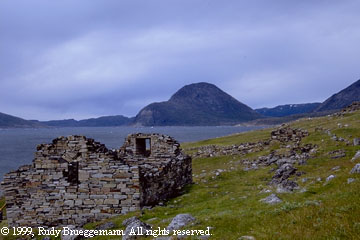
Needless to say, as gory as the cannibalism might have been, it does prove that the Vikings were not colorblind when they named today’s pure white glacier, Greenland.
Long before the industrial era, Greenland was so warm, wet and fertile that major colonization occurred after 980AD in conjunction with the Medieval Warming period. At its peak it included upwards of 10,000 settlers, extensive farming, numerous catholic churches and a parliament that eventually voted for union with Norway.
By contrast, during the Little Ice Age (1550-1850 AD), which wiped out the Greenland settlements, the global average temperatures became substantially colder.
 The Skeptical Environm...
Best Price: $2.51
Buy New $22.32
(as of 05:15 UTC - Details)
The Skeptical Environm...
Best Price: $2.51
Buy New $22.32
(as of 05:15 UTC - Details)
In Europe, glaciers came down the mountains, thereby covering houses and villages in the Swiss Alps, while canals in Holland froze for three months straight–a rare occurrence before or after. Agricultural productivity also dropped significantly, even becoming impossible in parts of northern Europe.
This brings us to the climatic Piltdown Mann – named for one Michael Mann, newly minted PhD in 1998 who became the IPCC’s (International Panel on Climate Change) lead investigator and advocate for what famously became the “hockey stick” proof of global warming.
The latter, of course, was the blatant fraud embedded in the image that Al Gore made famous in his propagandistic movie called “An Inconvenient Truth” in 2006. Suffice to say that the purpose of the hockey stick was to wipe out all of the evidence summarized above.
That is, in lieu of the planet’s long-term and recent severe climate oscillations, the IPCC posited an entirely opposite thesis. Namely, that for the pre-industrial millennium before 1900, global temperatures were nearly flat as a board.
Accordingly, only when the industrial age got a head of steam and reached full force after 1950 did today’s warming temperatures first appear, or so it was alleged. The suggestion, of course, was that an uncontrolled temperature breakout to the upside was well underway and that a planetary disaster was just around the corner.
The only problem is that Mann’s graph was as phony as the Piltdown Man that was confected in England in 1912 and conveniently “discovered” by an amateur anthropologist who claimed it was the missing link in human evolution. At length, it was shown that the fossil was a forgery; it consisted of a modern human cranium and an orangutan jaw with filed-down teeth.

In this case, professor Mann and his accomplices at the IPCC doctored the evidence, used misleading data from Southwestern US tree rings in lieu of abundant alternative data showing the contrary, and jiggered their computer models to generate preconceived results.
That is, the models were goal-seeked by Mann and his associates to prove the man-made warming thesis. In essence, it was accomplished by simply pasting modern temperature records showing steady increases on top of a pre-industrial baseline that never happened.
The phony pre-industrial baseline is depicted by the yellow area in the graph for the period 1400-1900. The hockey stick like eruption of the yellow space after 1900, of course, allegedly depicts the man-made temperature rise since the onset of the hydrocarbon age.
By contrast, the corrected version is in blue. In this version – which comports with the history of climate oscillations cited above – there is no hockey stick because the shaft never happened; it was invented by computer model manipulations, not extracted from the abundant scientific data bases on which the Mann study was allegedly based.
More importantly, when the 600 year time frame in the above graph is put in a longer 12,000 year historical framework, per the graph below, the whole hockey stick disappears entirely. Accordingly, long before the iron age (1200 to 700 BC) or even the rise of the great River Civilizations (3000 BC), which first made use of extensive man-made combustion, temperatures were often well higher than today.
That’s the “science” of the matter. And the $30 trillion economic disaster known as the Green New Deal designed to reverse so-called anthropogenic climate change advocated by Governor Nukesome and the Kamala Harris Regency is just as bogus as the claim that today’s raging wild fires in California are “a climate damn emergency”.
PEAK TRUMP, IMPENDING CRISES, ESSENTIAL INFO & ACTION
Reprinted with permission from David Stockman’s Contra Corner.




